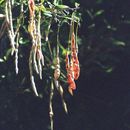en
names in breadcrumbs


Capparis cynophallophora, commonly known as the Jamaican caper, is small tree in the caper family, Capparaceae, that is native to the Neotropical realm.
The brand new leaves at the apical tips of twigs are folded in half showing only the whitish, hairy abaxial (lower or ventral) side of the leaf. The adaxial (upper or dorsal) side of the leaf is glossy and darker. Fruits are long and split to release several large, brown seeds.[3][4]
The native range of C. cyanophallophora includes Florida in the United States, Mexico, the Caribbean, Central America, and South America as far south as northern Argentina.[2] It inhabits mangrove forests, hammocks and shellmounds in coastal Florida and is extremely drought resistant
Capparis cynophallophora, commonly known as the Jamaican caper, is small tree in the caper family, Capparaceae, that is native to the Neotropical realm.